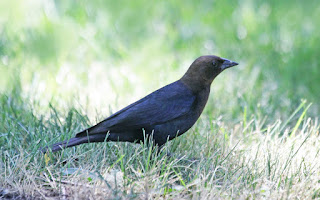Migration is over, at least for songbirds going north. Oh, there are a few wayward males that got here late or for some other reason never found a mate (no doubt, males would think all this is not their fault) that are singing, ever more weakly, most likely in vain, although a few may get involved in second broods. So, I suppose someone could say spring migration and its aftermath is still unwinding. But the forecast is for 100 degrees and, of course, the bulk of what is going on now involves the primary reason for migration: procreation.
At Grandview Cemetery at the west terminus of Mountain Avenue in Fort Collins, three things smack one's sensibilities these days: plastic flowers, our obsession with tidy grass and the nesting activity of birds.
I have focused on Broad-tailed Hummingbirds the last few years in summer. At present there are three active nests that I am aware of, all on the lower limbs of conifers, all have two young ranging from a few days out of the egg to a week+. Height of these nests above the ground is 4-7 feet. I am aware of three other nests that either produced young already or were predated. I believe the three active nests all represent 2nd broods for 2018 but have no proof of this in terms of the females involved being banded or otherwise marked and having been knowingly associated with a previous 2018 nest. The quickly-procured-by-cell-phone pics here show the same nest in a Colorado blue spruce before and just after egg hatch. I would describe the female as "attentive" but not "ballistic" during the documentation process.


At least 3 pairs of Chipping Sparrows nested at Grandview. At present the young have fledged and are in "half and half" mode as far as food acquisition: they are given half their food by attendant parents, find half their own. The latter involves a lot of investigation of wannabe food like dry leaves and other little dark things like rocks. Unlike most modern human children, it looks like young Chippers are allowed to fall off their bikes without having every boo-boo kissed ad nauseum.
Spotted, fledged robins are likewise foraging along side their parents, accepting chopped up earthworms, and whole worms, finding mulberries on the ground (purple ones are good, greenish-red ones aren't), hopping up in honeysuckle bushes for red berries, looking up for the big bad Red-tailed Hawks that nested nearby and that have a penchant for robin nuggets. All this is constantly punctuated by that staccato screech baby robins make.
At least one House Wren brood is out and about. I love to watch the tail rudder-challenged flights of the youngsters. No earwig, spider or daddy-longlegs harvestman appearing within their gaze is safe.
Both Barn and Cliff Swallows nest where the ditch goes under the busy Taft/Laporte Avenue intersection (Barn Swallows use mostly the east "door", Cliffs the west.
Every summer usually has one Common Nighthawk perching by day on the horizontal limbs of giant American Elms overhanging Laporte Avenue. 2018 is no exception. Not sure if such birds nest on a nearby flat roof or just hang out.
Other nesting species include House Finch, Lesser and American Goldfinch, Red-breasted and White-breasted Nuthatch, Blue Jay, Mallard (momma in the ditch has had her brood reduced to one duckling that never lets its beak be more than a centimeter behind her tail), Northern Flicker, Downy Woodpecker, House Sparrow, Eurasian Collared-Dove, European Starling, Common Grackle, and Black-capped Chickadee.
The Great Horned Owls pulled off the mini-miracle of having their young fledge. First time in three years, probably because we had no mega-storm this spring. It is amazing how two big parents and two big offspring can virtually disappear into the dark crowns of mature trees once they leave the nest tree. They are in the cemetery, but where?
Species that might be nesting include Cedar Waxwing, Mourning Dove and Bushtit. I see them every once in a while but have not noticed a pattern that would divulge nests.
The Western Wood-Pewee half-heartedly but persistently moving and singing a couple weeks ago has given up. Better luck next year.
Two days ago I saw my first Brown-headed Cowbird at Grandview, a male that pecked for over half an hour around headstones for something small and active: ants? In the past this nest parasite has exploited Ruby-crowned Kinglets for sure and probably others like House Finch and Chipping Sparrow. No females noted this year, which probably means nothing given their stealth.
I have not seen vultures from the various urban roosts in the neighborhood to the east of the cemetery in over a month. Maybe they have been profiled and exiled, maybe I just don't get over to the cemetery early or late enough in the day to see their commutes to the mountains.
Occasional fly-overs include Great Blue Heron, Chimney Swift, White Pelican, Double-crested Cormorant, Violet-green Swallow and Red-winged Blackbird.
That's the news from Grandview - no rarities, lots of interesting behaviors.
Dave Leatherman
Fort Collins



No comments:
Post a Comment